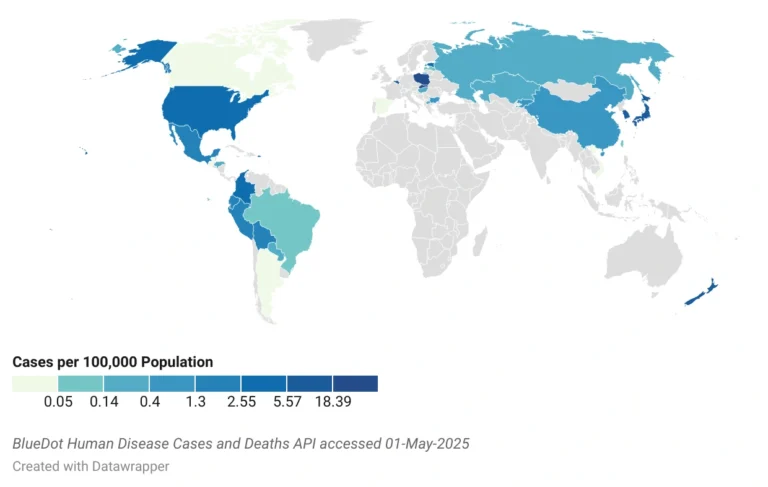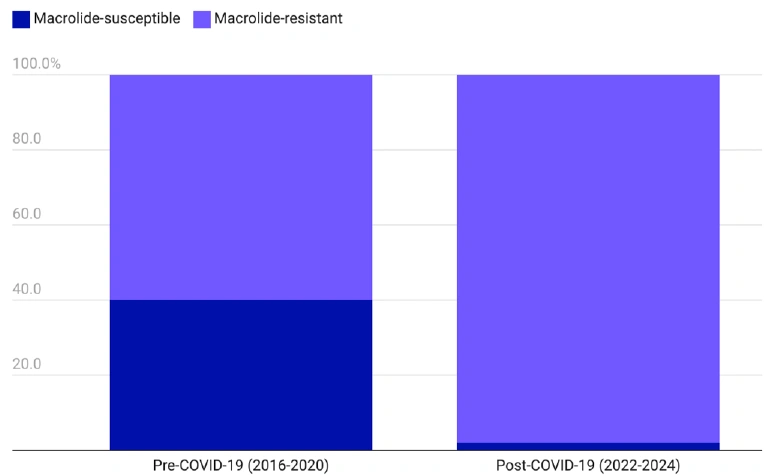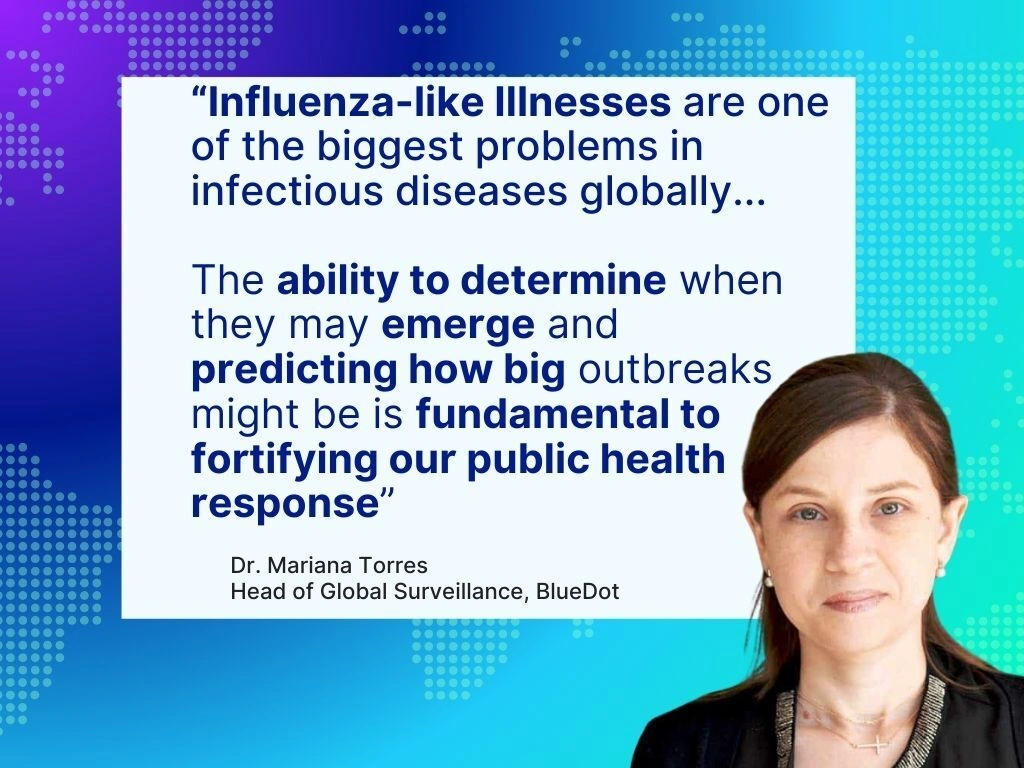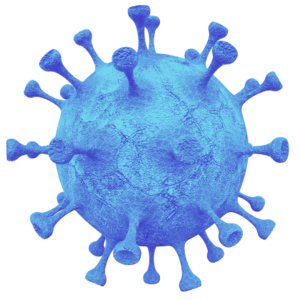Declining vaccination rates, waning immunity, antigenic variation, and antibiotic resistance threatens prevention and treatment for pertussis
After a period of low incidence during the COVID-19 pandemic, pertussis has made a dramatic return to the global stage. From Asia to the Americas, cases continue to grow worldwide following significant case count increases in 2024.
In the US since the start of 2025, nearly 8,500 cases were reported to April 19, double the cases reported in the same period last year. Texas is the national hotspot, with cases nearing 2,000 as the state also battles significant outbreaks of measles — another vaccine-preventable disease. Two infant deaths due to pertussis have already been reported in Louisiana, and a third in Washington; notably, one-third of all infected children are being hospitalized. On April 12, Mexico issued their second emergency alert this year as cases exceeded 2,500 probable cases and 37 deaths.
On the other side of the world, China reported nearly 17,000 cases as of April 20. This follows last year’s 40-year peak in that country, which saw approximately 500,000 cases and 31 deaths and sparked adjustments to the national immunization program. To the east, Japan has confirmed more than 5,600 cases to date this year, surpassing total cases for all of 2024.
The root of globally increased incidence is multifactorial. Many countries are reporting rising cases as vaccine coverage falls and immunity wanes. Others have reported antigenic variation, resulting in strains that are more severe or can evade vaccine-induced immunity. However, China is facing a unique predicament: 98% of pertussis cases are of an antibiotic-resistant strain.
“Increasing trends in vaccine-preventable infections raise concerns about larger outbreaks and concerning outcomes for at-risk populations,” says Dr. Mariana Torres Portillo, BlueDot’s head of surveillance. “The worry is exacerbated by the presence of antimicrobial resistance.” As this potentially life-threatening illness spreads, pertussis proves itself to be an ongoing global health challenge in need of improved tracking, diagnosis, treatment, and prevention.
The problem of pertussis
Pertussis, or whooping cough, is a highly contagious bacterial respiratory infection with documented epidemics since the 16th century. The disease is caused by the Bordetella pertussis pathogen, which was first isolated in 1906. Before vaccines became available, pertussis was a highly common childhood disease, resulting in over 200,000 cases every year in the US.
Whooping cough is primarily transmitted through respiratory droplets. Illness often presents like the common cold within the first two weeks of infection, with a runny or congested nose, mild cough, and maybe a low-grade fever. However, some people may develop uncontrolled coughing fits, causing the characteristic “whoop” sound of the disease. These serious coughing fits can last up to 10 weeks and worsen over time, leading to difficulty breathing and even rib fractures.
Serious complications may also emerge, such as apnea (life-threatening pauses in breathing), pneumonia, seizure, and encephalopathy, which are particularly concerning for babies too young to be vaccinated, and those non-immunized or under-vaccinated. In fact, one-third of babies who contract pertussis are hospitalized, and more than 160,000 children under 5 years of age die of the disease every year — most younger than 12 months.
Treatment for pertussis involves antibiotics to combat the bacteria causing illness. Typically, macrolides such as erythromycin, azithromycin, and clarithromycin are the first-line treatment options. These treatments are most effective when initiated early in the course of illness, as their impact diminishes once the infectious period has passed. Supportive care is also leveraged, whereas medical care may be needed for more severe cases.
Trends and catalysts for increased whooping cough cases
Despite the availability of preventative vaccines, pertussis is endemic around the globe, causing an estimated 20-40 million cases annually. The disease is present year-round and typically follows a cyclical pattern, with peaks occurring every 2-5 years. During the COVID-19 pandemic, incidence of pertussis was low. But since then, the wave of whooping cough cases has resulted in outbreaks that exceed pre-pandemic levels.
In a Pertussis Pulse Report published by BlueDot in November 2024, pertussis activity was found to have increased beyond 2023 rates across Europe, Asia, and the Americas. By October 2024, peak case counts had surpassed the pre-pandemic levels by more than 10% in several countries, including in France, South Korea, and Canada.
This year, trends continue to show high incidence of pertussis. Overshadowed by the concurrent measles outbreak, the US has already reported 8,484 cases of pertussis, representing a 99% increase compared to the same time last year. Given the nation saw more than 35,000 cases and 10 deaths in 2024 — the highest in over a decade — experts are concerned as US school-age vaccine coverage dips beneath the recommended threshold needed for community immunity and national public health spending cuts continue. Central and South America are reporting concerning rates amid declining vaccination coverage as well. Ecuador, Colombia, and Mexico have already seen cases surpass total counts from 2024, prompting the latter two countries to issue alerts.
Global Pertussis Incidence, January 1-April 30, 2025

Cases have also jumped in countries with high vaccination rates such as Japan, South Korea, and Hungary. In early April, Japan reported a sharp increase in pertussis as cases reached 5,652, representing a more than 3,200% increase from the same period last year. Similarly, South Korea has reported a 770% increase in cases compared to the same time last year, while trends in Hungary show record-highs so far, exceeding the pre-pandemic peak.
4 Top Takeaways
- Pertussis continues to peak globally. From Asia to the Americas, whooping cough soars as post-pandemic upward trends persist. Cases of the highly contagious respiratory illness have neared 17,000 in China, 8,500 in the US, and 5,700 in Japan so far this year.
- Reasons for pertussis resurgence are multifaceted. Declining vaccine coverage, waning immunity, and mutations in strains are key factors driving increased incidence and severity of pertussis. Still, the risk remains the greatest for children.
- Antibiotic resistance reduces effectiveness of pertussis treatment. China is facing an epidemic of macrolide-resistant pertussis, with most recent cases expressing drug resistance. The use of macrolides — pertussis’ first-line treatment — for other infections and ailments may result in widespread emergence of resistant strains.
- Dire need for improved disease defense. To prevent growing case counts and severe morbidity and mortality, enhanced prevention and treatment measures are needed, including a third-generation vaccine, a reduction in vaccine hesitancy, and bolstered surveillance.
Infection prevention and treatment challenges
When the pertussis vaccine was first introduced, it drastically reduced morbidity and mortality. But its “whole cell” design resulted in significant side effects that deterred use, leading to the development of a second-generation “acellular” vaccine. However, since the second-generation vaccine was rolled out in the 1990s, a key limitation has been identified: it prevents illness but doesn’t prevent people from carrying the bacteria. This means people can be asymptomatic carriers of the bacteria, inadvertently spreading it.
Recent evidence also suggests an increase in prevalence of both more virulent and macrolide-resistant pertussis, which can limit the effectiveness of both the vaccine and the antibiotic. Researchers hypothesize these pathogenic evolutions underlie the recent resurgence in China.
A study in Northern China found that high-virulence strains increased from 13.5% in 2019-2021 to 93% in 2022-2023, while erythromycin-resistant strains concurrently rose from 42.9% in 2019-2021 to 100% in 2022-2023. Likewise, in a recent study of pertussis epidemiology in Shanghai, a novel antimicrobial-resistant B. pertussis strain increased from 60% of all cases pre-pandemic to 98% post-pandemic.
Proportion of Bordetella pertussis Cases with Macrolide Resistance in Shanghai, China

Source: Fu et al., 2024 via BlueDot Pertussis Pulse, Issue 2, November 15, 2024.
While cases of macrolide-resistant pertussis have been documented in several countries, these have been at much lower frequencies compared to China, which accounts for the vast majority of such cases. It’s theorized that the transition to an acellular vaccine, overprescription of antibiotics for respiratory infections, and high population density are driving the spread of resistant strains across the country. Ultimately, the presence of these strains complicates treatment decision-making as macrolides must make way for alternative options — which are limited.
What’s needed in whooping cough prevention?
The arrival of more virulent and antimicrobial-resistant isolates poses a major global health threat. As such, the need for better approaches to prevent infection has intensified.
Pertussis vaccines have made huge strides in reducing cases worldwide. But the development of novel whooping cough vaccines that prevent infection, offer longer immunity, and combat antibiotic resistance are warranted given current immunization limitations. No third-generation vaccines are approved yet, but several promising candidates are being evaluated. Until then, experts encourage up-to-date vaccination to ensure at-risk populations are protected.
As macrolide resistance grows in China, limiting the spread of these strains becomes increasingly urgent. Local and regional health authorities might consider increasing awareness of resistant strains and improving sample screening to individualize treatment and avoid widespread impacts from these strains.
Importantly, strengthened disease surveillance systems are needed to more efficiently and effectively track trends and bacterial evolution. “It’s difficult to track and compare data around the globe,” says BlueDot’s head of epidemiology, Andrea Thomas, PhD. “With increased surveillance, we can better understand where vaccine coverage is low, immunity is waning, and more severe or macrolide-resistant strains may be.” With this information, public health organizations can identify and prioritize the most vulnerable populations.
On our radar
- Mpox in Africa: On April 25 and 26, 177 new cases of mpox were reported in Sierra Leone following screening operations among those suspected to be exposed to the virus. In 2025 so far, 763 cases and six deaths have been reported since the year’s first case on January 11. On the other side of the continent, Malawi confirmed its first two cases of mpox on April 17. The Africa CDC and the WHO have revised their joint Continental Response Plan to combat the mpox emergency.
- Dengue on the Pacific Islands: As of April 20, Fiji has reported 5,128 confirmed cases and three deaths, 2.5-fold higher than the total reported cases last year. Similarly, the nearby Pacific Island country of Tonga has also reported spikes in case counts this year, with approximately 600 cases and two deaths by late April. With tourism and regional connectivity, there is a risk for exported cases.
- Measles in Japan: As of April 13, Japan has reported 78 cases of measles — already surpassing total cases in 2024. Half of the cases are imported, including from nearby Vietnam, Thailand, and the Philippines, among those who are un- or under-vaccinated, or with unknown vaccination status. The nation joins a growing list of countries around the globe experiencing importation pressure and resurgence of this vaccine-preventable disease.
To be aware of infectious disease threats locally and abroad, sign up here to receive every edition of BlueDot’s biweekly newsletter, Outbreak Insider.









